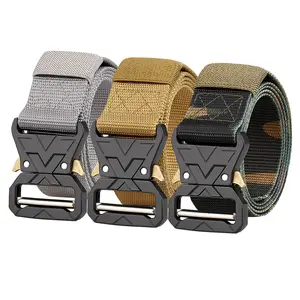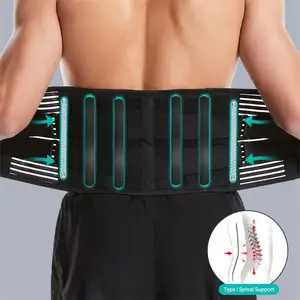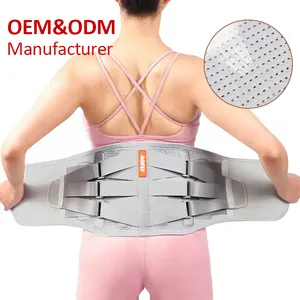The medical waist belt is an indispensable accessory for those in need of lumbar support and alleviation. This broad category includes a plethora of belts tailored to various requirements, from aiding postoperative recovery to managing daily discomfort. Each belt is meticulously engineered, incorporating materials and design elements that aim to deliver solace, firmness, and therapeutic advantages to the wearer.
Types and Characteristics of Medical Waist Belts
Among the array of medical waist belts, distinct variants are crafted for particular purposes. The surgical waist belt, typically more substantial and broader, offers significant abdominal support following surgery. For individuals grappling with persistent pain, belts equipped with heating elements or massage features provide extra relief. The insulin pump waist belt is a specialized design featuring compartments or clasps to securely accommodate insulin pumps, a vital aspect for patients needing uninterrupted access to their medication. Meanwhile, catheter waist belts offer a discreet and snug solution for those with urinary catheters, ensuring their bags are securely held. Each belt is purpose-built, guaranteeing the delivery of requisite support and functionality.
Structure and Operation of Medical Waist Belts
A medical waist belt boasts a sophisticated and deliberate construction. The core panel, typically made from dense foam or sturdy materials, provides primary support. This is enveloped by softer layers such as neoprene or mesh to ensure skin comfort. Adjustable straps with hook-and-loop fasteners ensure a secure fit, while some belts feature detachable elements like lumbar pads for added pressure or pockets for hot/cold packs. The belts' efficacy lies in their ability to deliver uniform support across the lower back, a result of the harmonious interplay of their components.
Materials and Their Properties
The selection of materials in medical waist belts is pivotal to their efficacy. Robust fabrics like nylon and polyester are chosen for their resilience to stress and resistance to tearing. Oxford cloth is especially prized for its sturdiness, often utilized in belts demanding greater support. Spandex is incorporated for its elasticity, enabling the belt to mold to the body's movements. Cotton and its blends are preferred for their natural breathability and gentleness, enhancing comfort for those who wear the belts for prolonged periods. These materials are typically combined or interwoven to strike a balance between firmness and pliability, offering essential support while remaining comfortable.
Business Usages and Applications
Medical waist belts are vital across various commercial environments. In healthcare, they assist patients during convalescence. In industries where back injuries are common due to heavy lifting or extended periods of sitting or standing—such as logistics, construction, or office settings—these belts are integral to preventive health measures. They also find use in sports, aiding athletes in both injury prevention and recuperation. The deployment of these belts in the workplace is not merely a health and safety initiative but also a savvy economic move, potentially curtailing costs linked to work-related injuries and bolstering overall productivity.
Functions of Medical Waist Belts
The medical waist belt fulfills multiple roles. Its chief function is to bolster the lower back through compression and stabilization, which can help realign the spine, diminish muscle fatigue, and mitigate discomfort. Certain belts are conceived with additional purposes in mind, such as the insulin pump waist belt, which not only supports the lumbar region but also securely houses medical apparatus. Others may incorporate therapeutic elements like magnets or vibration to further ease pain and enhance circulation.
Features and Unique Selling Points
Key attributes that set medical waist belts apart include their customizable fit, enabling users of varying statures to find a snug and effective compression level. Ergonomically crafted, these belts support without impeding movement. Many boast distinctive selling points, such as tailor-made lumbar supports that adapt to the user's physique, or advanced textiles that monitor posture and offer feedback. These innovations cater to the unique demands of users, distinguishing these products from conventional back-support belts.
Benefits and Positive Outcomes
Employing a medical waist belt can yield a multitude of advantages. For those suffering from acute or chronic back issues, these belts can offer prompt relief, facilitating daily activities with reduced pain. Postoperative patients may discover that a belt aids in safeguarding and stabilizing the surgical site, lessening the likelihood of complications and expediting recovery. For employers, providing medical waist belts to staff can result in a more vigorous, efficient workforce and signal a commitment to employee health.
How to Use and Maintain Medical Waist Belts
To effectively utilize a medical waist belt, it should be positioned around the waist, centering the main support panel on the back. Straps must be secured to a snug yet comfortable tightness, ensuring support without hindering blood flow. Belt maintenance is simple yet crucial for durability. Regular cleansing, following the manufacturer's guidelines, is imperative for hygiene and preserving the material's condition. Regular inspections for wear and tear are also essential, particularly for belts used frequently or under strenuous conditions.
Choosing and Cleaning the Right Medical Waist Belt
Selecting an appropriate medical waist belt entails evaluating specific support needs based on medical conditions or desired outcomes. Factors to consider include the level of support, adjustability for an accurate fit, and any supplementary features that may prove beneficial, such as compartments for hot/cold packs or spaces for medical devices. Cleaning should be approached with caution, using mild detergents and avoiding harsh chemicals or fabric softeners that could compromise the materials. Air drying is advised to maintain the belts' elasticity and fastening properties.
Target Audience and Meeting Needs
The intended demographic for medical waist belts is wide-ranging and encompasses anyone in need of extra back support. This includes seniors, individuals with persistent back pain, those recovering from surgery, athletes, and workers in physically taxing roles. The design of each belt is considerate of the varied requirements of these groups, ensuring that the product not only furnishes support but also fits comfortably and satisfies the specific needs of the user.
Discover the extensive selection of medical waist belts on Alibaba.com to find the ideal solution for your requirements, whether for personal application or to equip your healthcare establishment.











































 浙公网安备 33010002000092号
浙公网安备 33010002000092号 浙B2-20120091-4
浙B2-20120091-4